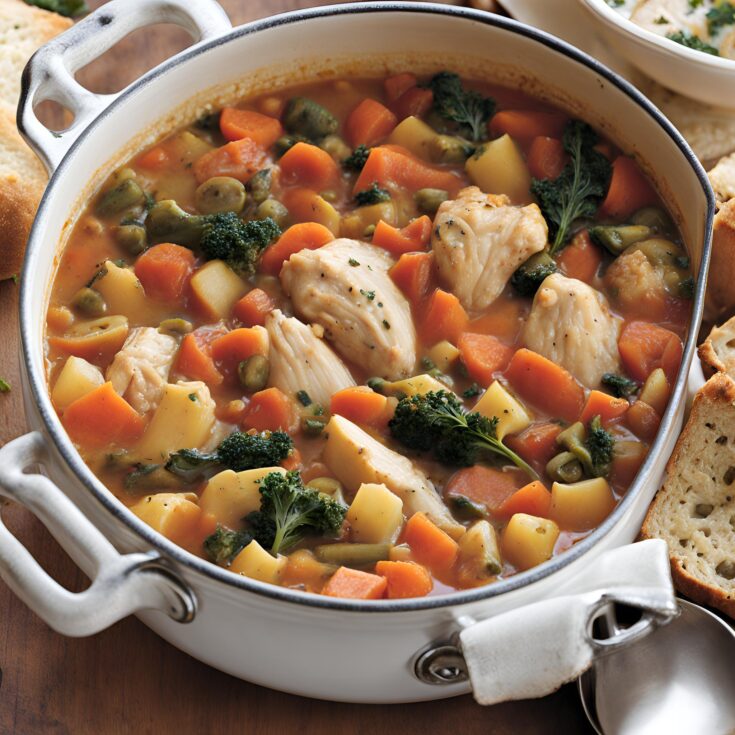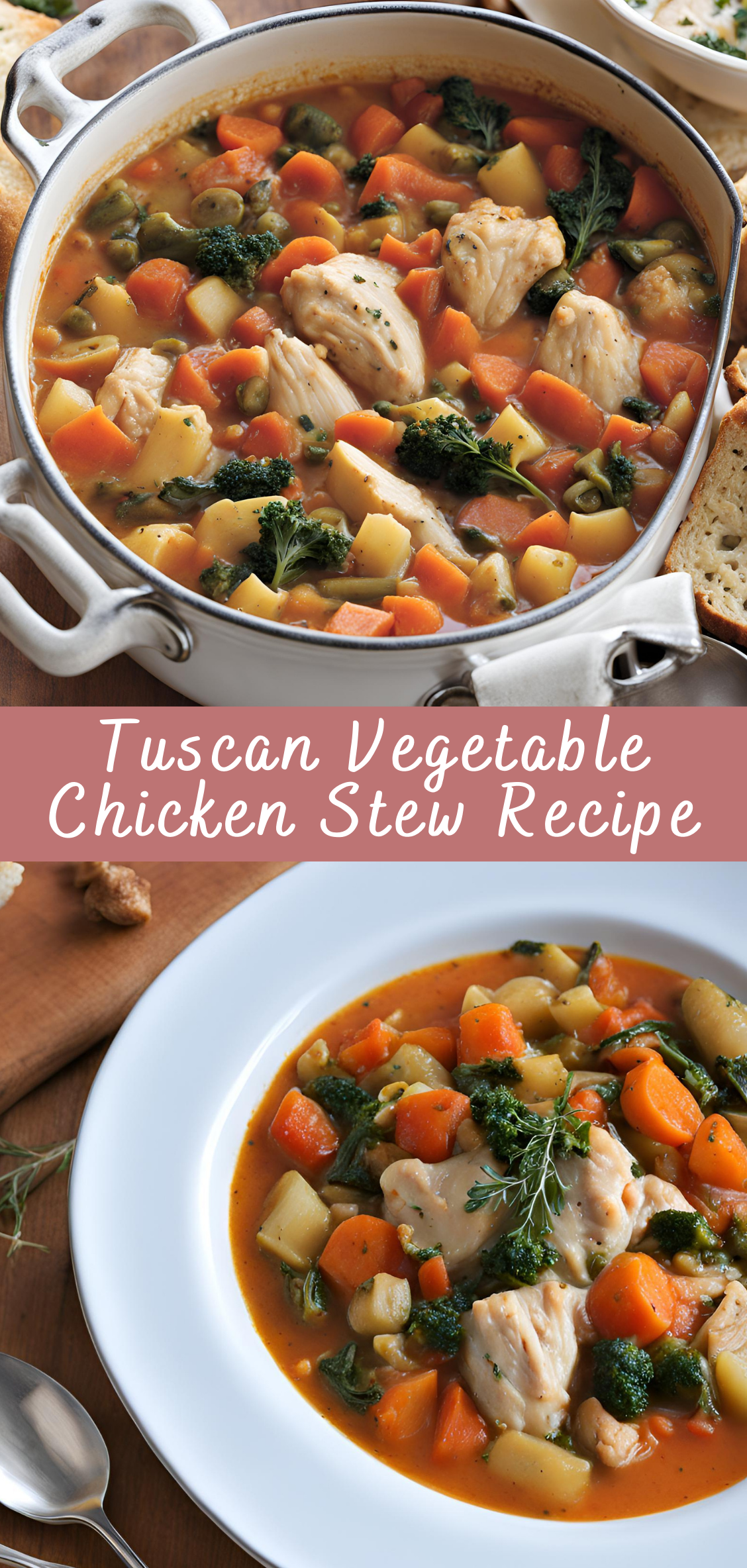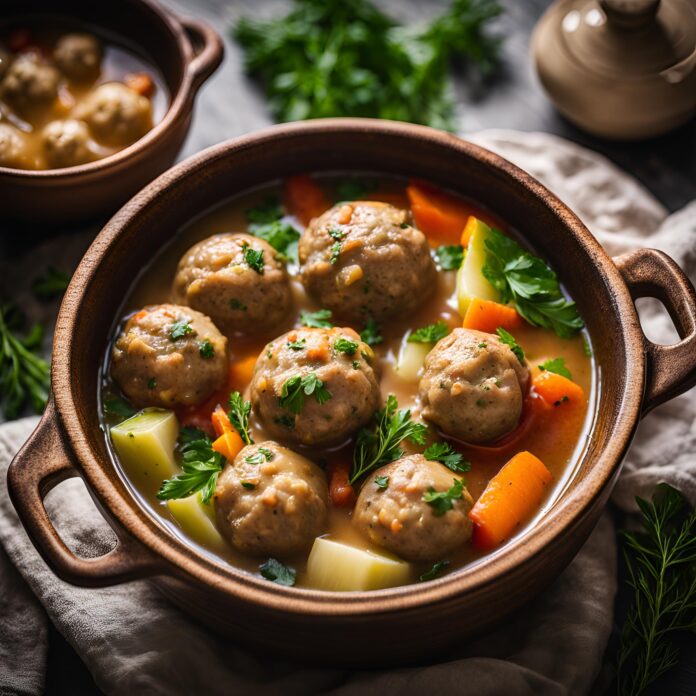Tuscan Vegetable Chicken Stew Recipe
Tuscan cuisine is well-known for its rich, rustic flavors, often showcasing fresh vegetables, tender meats, and fragrant herbs. A Tuscan Vegetable Chicken Stew is a perfect example of the comforting, soul-satisfying meals that the region of Tuscany is famous for. Combining juicy, tender chicken with a medley of seasonal vegetables, hearty beans, and a rich, flavorful broth, this stew is perfect for cold weather or when you’re craving a wholesome, nourishing meal.

This stew is versatile and can be made in a variety of ways depending on what ingredients you have on hand. It’s an easy, one-pot meal that’s both filling and healthy, making it an ideal choice for family dinners, meal prep, or dinner parties.
Preparation Steps
1. Marinading the Chicken (Optional)
Marinating the chicken is an optional step but highly recommended if you want extra flavor. The marinade helps tenderize the meat and infuses it with herbaceous, zesty notes.
- In a small bowl, whisk together the olive oil, dried rosemary, garlic powder, lemon juice, salt, and pepper.
- Coat the chicken thighs with the marinade and let it sit for at least 30 minutes in the refrigerator. If you have more time, marinate the chicken for up to 4 hours to allow the flavors to deepen.
2. Searing the Chicken
- In a large, heavy-bottomed pot or Dutch oven, heat 1 tablespoon of olive oil over medium-high heat.
- When the oil is hot, add the chicken thighs, skin-side down, and cook for 4-5 minutes per side, until golden brown. The chicken will not be fully cooked at this point, but browning it helps develop rich, deep flavors.
- Remove the chicken from the pot and set it aside. You’ll finish cooking it later in the stew.
3. Sautéing the Vegetables
- In the same pot, add a bit more olive oil if needed. Reduce the heat to medium and add the chopped onion. Cook for 3-4 minutes, stirring occasionally, until the onion is softened and translucent.
- Add the garlic, carrots, celery, zucchini, and yellow potato to the pot. Stir and cook for another 5-7 minutes, until the vegetables start to soften and become fragrant.
- Stir in the tomato paste, cooking for 2 minutes to caramelize it slightly and intensify its flavor.
4. Deglazing the Pot
- Add the dry white wine (if using) to the pot, scraping the bottom to release any caramelized bits from the chicken and vegetables. Let the wine simmer for 2-3 minutes, allowing it to reduce slightly.
5. Simmering the Stew
- Pour in the chicken broth, followed by the diced tomatoes and their juices, the white beans, and the dried oregano, thyme, rosemary, and bay leaf.
- Stir to combine, then return the browned chicken thighs to the pot. Bring the stew to a simmer over medium heat. Reduce the heat to low and let it simmer for 25-30 minutes, or until the chicken is fully cooked and the vegetables are tender.
6. Shredding the Chicken
- Once the chicken is fully cooked (it should reach an internal temperature of 165°F), remove the thighs from the pot and place them on a cutting board. Let the chicken rest for a few minutes before shredding it into bite-sized pieces using two forks. Discard the bones.
- Return the shredded chicken to the stew and stir to combine.
7. Finishing Touches
- Stir in the fresh spinach (or kale) and cook for another 3-4 minutes until the greens are wilted and tender.
- Taste the stew and adjust the seasoning with salt and pepper as needed. You can also add a splash more of chicken broth if the stew has thickened too much.
8. Serving
- Ladle the stew into bowls and garnish with chopped fresh parsley and a sprinkle of Parmesan cheese (if desired).
- Serve the stew hot with crusty bread or a side of garlic bread to soak up the delicious broth.
Serving Suggestions
Tuscan Vegetable Chicken Stew is perfect on its own, but you can elevate the meal with these sides:
- Crusty Bread: A thick slice of sourdough, baguette, or ciabatta is perfect for sopping up the flavorful broth.
- Garlic Bread: For an extra indulgence, serve the stew with warm, crispy garlic bread to dip into the broth.
- Italian Salad: A light, fresh salad made of arugula, tomatoes, red onions, and balsamic vinegar balances the richness of the stew.
- Cheese Plate: If you’re serving the stew as part of a larger Italian meal, pair it with a simple cheese platter featuring Parmigiano Reggiano, mozzarella, and pecorino.
Variations
Tuscan Vegetable Chicken Stew is highly adaptable and can be customized to suit your tastes. Here are some variations you can try:
- Meat Variations:
- Turkey: Swap the chicken thighs for ground turkey or turkey breast for a lighter stew.
- Pork: For a different flavor profile, try adding pork tenderloin or pork shoulder in place of the chicken.
- Beef: Though not typical in Tuscan stew, beef stew meat or shredded roast beef would work well for a heartier version.
- Vegetarian Version:
- Omit the chicken and use vegetable broth as a base for a vegetarian Tuscan stew. Add additional hearty vegetables like butternut squash or sweet potatoes, and throw in some tofu or tempeh for protein.
- Beans: If you prefer a different type of bean, kidney beans, chickpeas, or black beans can easily replace the cannellini beans. Choose based on your preference for flavor and texture.
- Spicy Option:
- Add crushed red pepper flakes or fresh chili peppers to the stew to give it a little heat. This works particularly well if you love spicy Italian dishes.
- Pasta Version:
- Add small pasta shapes like orzo, farro, or ditalini to the stew towards the end of cooking. This transforms the stew into a more substantial meal and is very typical of Italian cuisine.
Cooking Tips
- Browning the Chicken: Don’t skip the step of browning the chicken! This creates a richer base for the stew and adds depth to the overall flavor.
- Cooking Time: Stews generally improve with time, so this dish can be made a day or two ahead of time. The flavors will continue to develop, and the stew will be even more delicious when reheated.
- Stovetop vs. Slow Cooker: If you prefer using a slow cooker, you can sauté the vegetables and brown the chicken in a pan, then transfer everything to the slow cooker. Cook on low for 6-8 hours or on high for 3-4 hours. Shred the chicken once cooked and return it to the pot.
- Freezing: This stew freezes wonderfully! Let it cool completely, then store it in an airtight container or freezer-safe bag for up to 3 months. When reheating, add a bit more broth to loosen it up.
Flavor Profile and Cooking Techniques
Flavor Development
The beauty of Tuscan Vegetable Chicken Stew lies in its balance of flavors—earthy, savory, and fresh. Every step in the recipe contributes to building depth, from sautéing the vegetables to browning the chicken to slow-simmering the broth. This creates a stew that is deeply satisfying while allowing each individual ingredient to shine.
- Herbs and Seasoning: The key herbs in Tuscan cuisine are typically rosemary, thyme, and oregano. These dried herbs are robust and earthy, perfect for hearty stews. They help infuse the broth with warm, aromatic flavors. The use of garlic, tomato paste, and dried bay leaves in the stew also adds layers of complexity to the base, giving it a rich, savory depth that balances the vegetables and chicken.
- Braising and Searing: The process of searing the chicken thighs creates a Maillard reaction—a chemical reaction between amino acids and reducing sugars that gives browned meat its distinctive flavor. This step is essential for building that deep, savory flavor in the broth and providing texture contrast with the tender, shredded chicken.
- Simmering: Slow simmering the stew is crucial for allowing all the ingredients to meld together. As the chicken releases its juices into the broth, it intensifies the flavor of the vegetables, beans, and herbs. The longer the stew simmers, the more integrated the flavors become. That said, this stew can be made ahead of time, and it will only improve in flavor after sitting overnight.
Pairing Wines with Tuscan Vegetable Chicken Stew
A dish that draws inspiration from Tuscan flavors naturally pairs well with wines from the region. Here are some options for pairing:
- White Wine Pairing:
- Pinot Grigio: A light, crisp Pinot Grigio will complement the delicate flavors of the chicken and vegetables without overpowering the dish. The acidity of the wine works wonderfully with the broth-based stew.
- Vermentino: This white wine from Tuscany has citrus and herbal notes that can enhance the brightness of the stew’s vegetables while providing a refreshing contrast to the richness of the broth.
- Red Wine Pairing:
- Chianti: The classic Tuscan red wine, Chianti, is a great choice. Its balanced acidity and notes of red fruit and herbs make it an ideal pairing with the stew. The tannins also help cut through the richness of the chicken and broth.
- Sangiovese: Another red from Tuscany, Sangiovese offers a slightly earthier note that complements the savory flavors of the stew while enhancing the herbs and tomatoes in the broth.
- Non-Alcoholic Pairing:
- If you prefer a non-alcoholic option, a sparkling apple cider or sparkling water with a slice of lemon can add a refreshing, zesty contrast to the richness of the stew.
Nutritional Considerations and Modifications
Tuscan Vegetable Chicken Stew is inherently a balanced and healthy dish. However, depending on your dietary needs, there are several ways to modify it:
Low-Carb Version:
If you’re following a low-carb or keto diet, you can replace the potatoes with cauliflower. It will provide a similar texture without the carbs. Additionally, if you want to keep the stew more vegetable-centric, you can opt for spinach or kale as the primary greens, leaving out beans for a lighter meal.
Low-Sodium Version:
If you’re concerned about sodium intake, use low-sodium chicken broth and no-salt-added canned tomatoes. You can also control the amount of salt you add to the stew by seasoning to taste toward the end of cooking. It’s a great way to enjoy the flavors without worrying about excessive sodium.
Dairy-Free and Gluten-Free:
This recipe is naturally both gluten-free and dairy-free. However, if you want to make it vegan, you can substitute the chicken with tofu, tempeh, or plant-based chicken alternatives. You can also skip the Parmesan cheese topping to maintain the dairy-free option.
Cooking Tips for Success
1. Make Sure to Brown the Chicken Properly
When browning the chicken thighs, make sure not to crowd the pan. If the chicken pieces are too close together, they will steam instead of sear, preventing that golden-brown crust that adds so much flavor. Browning the chicken is an essential step for developing rich flavor in the broth, so don’t rush this process.
2. Control the Heat
Once you add the broth and vegetables, ensure that the stew simmers gently rather than boiling rapidly. Simmering on low heat for an extended period ensures the flavors develop slowly and evenly. High heat could break down the chicken too much or cause the broth to reduce too quickly.
3. Taste and Adjust Seasonings
As the stew simmers, take the time to taste and adjust the seasoning. Some canned tomatoes and broth can be salty, so always check the salt levels toward the end of cooking. If the stew tastes flat, a splash of red wine vinegar or a squeeze of lemon juice can brighten up the flavors.
Serving Ideas and Presentation
To create a stunning meal, presentation is key. Here are some ways to elevate the serving experience:
- Garnish: A sprinkling of fresh parsley not only adds a pop of color but also enhances the dish with freshness. If you enjoy cheese, adding freshly grated Parmesan or a crumbled Pecorino Romano can bring a rich, salty finish to the stew.
- Bread: Serve with a thick, crusty loaf of sourdough or ciabatta, allowing guests to dip into the broth. A little garlic butter spread on the bread before toasting can make it even more irresistible.
- Side Salads: Pair the stew with a simple, crisp Italian-style salad with mixed greens, cherry tomatoes, cucumber, and a balsamic vinaigrette. The acidity from the dressing will cut through the richness of the stew.
- Wine Glasses: If you are serving wine with the stew, opt for a stemless wine glass for a relaxed, casual vibe. For more formal settings, use traditional red wine glasses that enhance the wine’s bouquet.
Reheating:
- Reheat the stew on the stovetop over low heat, stirring occasionally. Add extra broth or water if it has thickened too much.
- If you’re reheating from frozen, allow it to thaw in the fridge overnight, or use the stovetop on low heat, adding a splash of broth or water to loosen the stew.
Conclusion
Tuscan Vegetable Chicken Stew is a rich, comforting dish that embodies the essence of rustic Italian cooking. From the carefully browned chicken thighs to the vibrant mix of vegetables and tender beans, every element of this stew is designed to create a nourishing, satisfying meal. It’s perfect for any occasion—whether a family dinner, a cozy weekend meal, or as part of a larger Italian-inspired feast.
This stew is easy to adapt, whether you’re looking to make it vegetarian, adjust the seasonings to your taste, or add your favorite vegetables. It’s a versatile, customizable dish that’s both filling and full of vibrant flavors. Plus, with the option to make it ahead of time and store leftovers, it’s a practical and delicious meal for busy days.
Tuscan Vegetable Chicken Stew is a comforting and hearty dish that’s perfect for feeding a crowd or preparing for meal prep. With its combination of tender chicken, nutrient-packed vegetables, and deliciously seasoned broth, it offers warmth and nourishment in every bite. Whether you stick with the classic ingredients or experiment with variations, this stew is sure to become a favorite in your recipe rotation.
Enjoy this Tuscan classic, and let it bring warmth, comfort, and authentic Italian flavor to your table!
Tuscan Vegetable Chicken Stew Recipe

Tuscan cuisine is well-known for its rich, rustic flavors, often showcasing fresh vegetables, tender meats, and fragrant herbs. A Tuscan Vegetable Chicken Stew is a perfect example of the comforting, soul-satisfying meals that the region of Tuscany is famous for. Combining juicy, tender chicken with a medley of seasonal vegetables, hearty beans, and a rich, flavorful broth, this stew is perfect for cold weather or when you're craving a wholesome, nourishing meal.
Ingredients
- For the Chicken Stew:
- 1.5 lbs bone-in, skinless chicken thighs (You can also use chicken breasts or chicken legs, but thighs add a richer flavor)
- 1 tablespoon olive oil
- 1 medium yellow onion, chopped
- 2 cloves garlic, minced
- 2 medium carrots, peeled and diced
- 2 celery stalks, chopped
- 1 large zucchini, chopped
- 1 large yellow potato, peeled and diced
- 1 cup green beans, trimmed and chopped
- 1 can (14.5 oz) diced tomatoes, with juices
- 1 can (15 oz) white beans (such as cannellini or great northern beans), drained and rinsed
- 4 cups low-sodium chicken broth
- 1 cup dry white wine (optional, for depth of flavor)
- 1 tablespoon tomato paste
- 1 teaspoon dried oregano
- 1 teaspoon dried thyme
- 1/2 teaspoon dried rosemary (or fresh rosemary, finely chopped)
- 1 bay leaf
- Salt and pepper, to taste
- 2 cups fresh spinach (or kale for a more robust flavor)
- Fresh parsley, chopped (for garnish)
- Parmesan cheese (for garnish, optional)
- For the Chicken Marinade (Optional):
- 1 tablespoon olive oil
- 1 teaspoon dried rosemary
- 1 teaspoon garlic powder
- 1 teaspoon lemon juice
- Salt and pepper, to taste
Instructions
1. Marinading the Chicken (Optional)
Marinating the chicken is an optional step but highly recommended if you want extra flavor. The marinade helps tenderize the meat and infuses it with herbaceous, zesty notes.
- In a small bowl, whisk together the olive oil, dried rosemary, garlic powder, lemon juice, salt, and pepper.
- Coat the chicken thighs with the marinade and let it sit for at least 30 minutes in the refrigerator. If you have more time, marinate the chicken for up to 4 hours to allow the flavors to deepen.
2. Searing the Chicken
- In a large, heavy-bottomed pot or Dutch oven, heat 1 tablespoon of olive oil over medium-high heat.
- When the oil is hot, add the chicken thighs, skin-side down, and cook for 4-5 minutes per side, until golden brown. The chicken will not be fully cooked at this point, but browning it helps develop rich, deep flavors.
- Remove the chicken from the pot and set it aside. You’ll finish cooking it later in the stew.
3. Sautéing the Vegetables
- In the same pot, add a bit more olive oil if needed. Reduce the heat to medium and add the chopped onion. Cook for 3-4 minutes, stirring occasionally, until the onion is softened and translucent.
- Add the garlic, carrots, celery, zucchini, and yellow potato to the pot. Stir and cook for another 5-7 minutes, until the vegetables start to soften and become fragrant.
- Stir in the tomato paste, cooking for 2 minutes to caramelize it slightly and intensify its flavor.
4. Deglazing the Pot
- Add the dry white wine (if using) to the pot, scraping the bottom to release any caramelized bits from the chicken and vegetables. Let the wine simmer for 2-3 minutes, allowing it to reduce slightly.
5. Simmering the Stew
- Pour in the chicken broth, followed by the diced tomatoes and their juices, the white beans, and the dried oregano, thyme, rosemary, and bay leaf.
- Stir to combine, then return the browned chicken thighs to the pot. Bring the stew to a simmer over medium heat. Reduce the heat to low and let it simmer for 25-30 minutes, or until the chicken is fully cooked and the vegetables are tender.
6. Shredding the Chicken
- Once the chicken is fully cooked (it should reach an internal temperature of 165°F), remove the thighs from the pot and place them on a cutting board. Let the chicken rest for a few minutes before shredding it into bite-sized pieces using two forks. Discard the bones.
- Return the shredded chicken to the stew and stir to combine.
7. Finishing Touches
- Stir in the fresh spinach (or kale) and cook for another 3-4 minutes until the greens are wilted and tender.
- Taste the stew and adjust the seasoning with salt and pepper as needed. You can also add a splash more of chicken broth if the stew has thickened too much.
8. Serving
- Ladle the stew into bowls and garnish with chopped fresh parsley and a sprinkle of Parmesan cheese (if desired).
- Serve the stew hot with crusty bread or a side of garlic bread to soak up the delicious broth.



